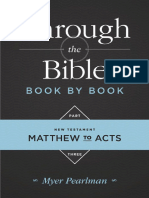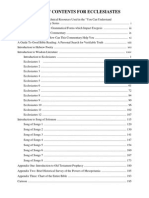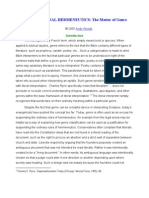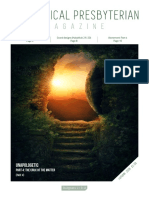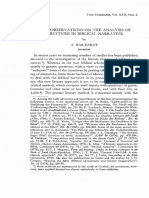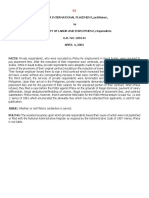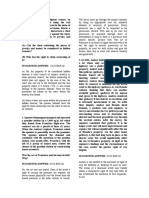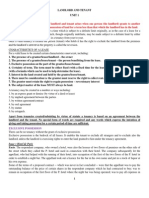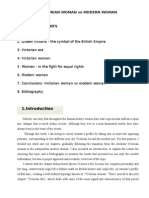Resources For The Journey
Resources For The Journey
Uploaded by
Virginia MCCopyright:
Available Formats
Resources For The Journey
Resources For The Journey
Uploaded by
Virginia MCOriginal Title
Copyright
Available Formats
Share this document
Did you find this document useful?
Is this content inappropriate?
Copyright:
Available Formats
Resources For The Journey
Resources For The Journey
Uploaded by
Virginia MCCopyright:
Available Formats
Resources for the Journey
1. Biblical Story
Ewert, David, How to Understand the Bible (2000). o A good basic text for how to interpret scripture and understand the basic kinds of literature in the Bible. Foster, Richard, Life with God: Reading the Bible for Spiritual Transformation (2008). Hershberger, Michele, Gods Story, Our Story (2003). o A basic overview of the biblical story from a Christ-centered Anabaptist/Mennonite approach. Wald, Oletta, The Joy of Discovery in Bible Study (1975). o A good introduction to inductive Bible study. Wenger, J. C., Gods Word Written (1966). o Older, but a good basic text for understanding how the Bible came to be, its authority, meaning, importance of a Christ-centered approach, how it has been transmitted and translated. Wright, G. Ernest, God Who Acts: Biblical Theology as Recital (1969). o An old but basic text for understanding God as the center and moving agent in Old Testament history which moves on into the New.
2. Anabaptist/Mennonite Principles
Becker, Palmer, What is an Anabaptist Christian (2008). o Available online at www.MennoniteMission.net. A good, easily remembered updating of the three core Anabaptist principles in Harold S. Benders The Anabaptist Vision. Dyck, C. J., ed., An Introduction to Mennonite History (1981). o Basic text for learning Anabaptist/Mennonite History, beginning before the Reformation and continuing to the 20th Century. Chapter 8 offers a summary of the Anabaptist Vision. Junke, James C. and Hunter, Carol M., The Missing Peace: The Search for Nonviolent Alternatives in United States History (2001). o Invites a wonderful rethinking of t violence-centered US history by imagining how conflicts that were dealt with by war might have been resolved peacefully. ____, Practices: Mennonite Worship and Witness (2009). o Wrestles with issues of worship and witness in the context of a post-modern culture, inviting a return to Christ- centered, simple, communal, life-sharing, visible commitments. Krabill, Donald B., The Upside-Down Kingdom (1978, 2003). o A masterful companion to The Politics of Jesus, explicating the principle of revolutionary subordination in the life and ministry of Jesus. Places Jesus in his own historical-cultural setting and invites us to apply his principles in our own time and place.
2 Murray, Stuart, The Naked Anabaptist: The Bare Essentials of a Radical Faith (2010). o Presents seven core Anabaptist principles as experienced by Anabaptistminded believers in the British Isles. Roth, John D., Stories: How Mennonites Came to Be (2006). o An easy to read sweeping history of the church beginning with the New Testament and tracing the story forward with a central focus on the Anabaptist/Mennonite story. ____, Beliefs: Mennonite Faith and Practice (2005). o Written before Stories, but a good follow-up, focusing on central Mennonite beliefs in the context of the beliefs of other Christians. A good companion to Confession of Faith in a Mennonite Perspective. ______, Choosing Against War: A Christian View (2002). o Another good, and more readable companion to Yoders work. Snyder, Arnold, Following in the Footsteps of Christ: The Anabaptist Tradition (2004). Yoder, John Howard, The Politics of Jesus (1972, 1994). o A seminal introduction to the non-violent way of Jesus.
3. Christian Spirituality/Discipleship
Augsburger, David, Dissident Discipleship: A Spirituality of Self-Surrender, Love of God, and Love of Neighbor (2006). Baker, Howard, Soul Keeping: Ancient Paths of Spiritual Direction (1998). Ive found this to be a wonderful introduction to a variety of ways to nurture and develop the inner spirit. Barton, Ruth Haley, Invitation to Solitude and Silence: Experiencing God's Transforming Presence (2004, 2010). o (a helpful book from a more evangelical perspective) Boers, Paul Arthur, et al, Take Our Moments and Our Days: An Anabaptist Prayer Book (2010). Boers, Arthur Paul, Lord, Teach Us to Pray (1992). This book has helped enrich my own use of the Lords Prayer as a guide to my daily morning prayers. _____, The Rhythm of Gods Grace: Uncovering Morning and evening Prayer (2003). A good introduction to the practice of contemplative liturgical prayer informed by the way of monastic praying. Bonhoeffer, Dietrich, The Cost of Discipleship (1959). A classic on understanding and commitment to living out a costly grace. Celtic Daily Prayer from the Northumbria Community (this inspired Shane's book above) Clairborne, Shane, et al, Common Prayer: A Liturgy for Ordinary Radicals (2010). Includes songs at the end. Foster, Richard, Prayer: Finding the Heart's True Home (1992). ______, Celebration of Discipline: The Path to Spiritual Growth (1978, 1988) A basic introduction to the inward, outward and corporate spiritual disciplines. A classic.
3 Guenther, Margaret, At Home in the World: A Rule of Life for the Rest of Us (2006). o This book has a chapter on "Learning from our enemies"-- forgiving as a spiritual discipline. Hamilton-Poore, Sam, Earth Gospel: A Guide to Prayer for God's Creation (2009 o Excellent for those involved in Creation Care! Janzen Longacre, Doris, Living More with Less: 30th Anniversary Edition, revised by Valerie Weaver-Zuercher (2010). Kropf, Marlene and Eddy Hall, Praying with the Anabaptists: The Secret of Bearing Fruit (1994). May, Gerald, The Awakened Heart (1993). Miller, Wendy, Invitation to Presence (1995). Newell, J. Philip, Celtic Benediction: Morning and Night Prayer (2000). Pennington, M Basil, O.C.SO., A Place Apart: Monastic Prayer and Practice for Everyone (1983, 1998). Makes contemplative monastic prayer accessible to more active Christians. Peterson, Eugene H., The Contemplative Pastor: Returning to the Art of Spiritual Direction (1989). Helps a pastor move from frantic busyness to living and ministering out of the being-center. Rice, Howard, The Pastor as Spiritual Guide (1999). Schrock, Daniel P, Prayer Practices for Terrifically Busy People (2011). o (written by a Mennonite spiritual director) Steere, Douglas V., Dimensions of Prayer - Cultivating a Relationship with God (1997). Thompson, Marjorie, Soul Feast: An Invitation to the Christian Spiritual Life (2005). o (I have used this in a SS class) Wallis, Jim, Rediscovering Values: A Guide to Economic and Moral Recovery (2010). Willard, Dallas, Renovation of the Heart: Putting on the Character of Christ (2002).
4. Self Understanding and Self-Awareness
Biehl, Bobb, Stop Setting Goals: If you would rather solve problems (1995). Friedman Edwin H., Generation to Generation: Family Process in Church and Synagogue (1985). o A classic introduction to family systems theory, moving from the pastor as a person, to the pastors family and the congregation. Explores five basic components in family systems theory: identified patient; homeostasis (balance), self-differentiation, extended family field, and emotional triangles. Richardson, Ronald W., Becoming a Healthier Pastor: Family Systems Theory and the Pastors Own Family (2005). o A good down-to-earth introduction to emotional systems in the pastors own life, family and congregation.
5. Contextual Awareness
Ammerman, Nancy T, et al, Studying Congregations: A New Handbook (1998).
4 o An excellent guide for studying and understanding a congregation in the context of its wider community and cultures. Boyd, Gregory, The Myth of a Christian Nation: How the Quest for Political Power is Destroying the Church (2007). Steinke, Peter L., How Your Church Family Works: Understanding Congregations as Emotional Systems (1993). o Offers basic understanding of the dynamics in the local congregation from the family systems perspective. ______, Healthy Congregations: A Systems Approach (1996). o A good follow-up companion to How Your Church Family Works.
6. Leadership.
Barton, Ruth Haley, Strengthening the Soul of Your Leadership: Seeking God in the Crucible of Ministry (2008). Blanchard, Ken and Phil Hodges, Lead like Jesus (2008). Covey, Stephen R, Principle-Centered Leadership (1992). Esau, John A., ed., Understanding Ministerial Leadership (1995). o A collection of essays by Mennonite professors and pastors on a variety of pastoral leadership dimensions. Greenleaf, Robert K., Servant Leadership: A Journey into the Nature of Legitimate Power and Greatness (1977). o A key work by a Quaker author on leadership and its expression in the wider world, a variety of institutions and the church. Nouwen, Henri J. M., In the Name of Jesus: Reflections on Christian Leadership (1989). o Works with the three temptations of Jesus to chart a course for leading in the manner of Jesus: from relevance to prayer; from popularity to ministry; and from leading to being led. Peterson, Eugene H., Five Smooth Stones for Pastoral Work (1980). o Offers insight into five dimensions of pastoral work utilizing Old Testament material: Prayer-Directing (Song of Songs); Story-Making (Ruth); Pain-Sharing (Lamentations); Nay-Saying (Ecclesiastes); and Community Building (Esther) ______, Working the Angles: The Shape of Pastoral Integrity (1987). o Focuses on the pastoral priorities of prayer, scripture and spiritual direction ______, Under the Unpredictable Plant: An Exploration in Vocational Holiness (1992). o Draws powerful parallels between moves in the Jonah story and the pastoral journey Sawatsky, Erick, ed., The Heart of the Matter: Pastoral Ministry in Anabaptist Perspective (2004). o A collection of essays on various aspects of pastoral ministry by professors of Associated Mennonite Biblical Seminary.
You might also like
- Exploding The Limits: Form and Function in Psalm 2Document14 pagesExploding The Limits: Form and Function in Psalm 2Enrique VeraNo ratings yet
- JOHN Through The Bible New TestamentDocument19 pagesJOHN Through The Bible New TestamentJoshua TeodoroNo ratings yet
- ImageDocument111 pagesImageJair Villegas BetancourtNo ratings yet
- PHILIPPIANS 2 - 5 - 11 RECENTO ST - Rober B. StrimpleDocument23 pagesPHILIPPIANS 2 - 5 - 11 RECENTO ST - Rober B. StrimpleRichard Mayer Macedo SierraNo ratings yet
- 2010 - F. Scott Spencer - Scripture, Hermeneutics, and Matthew's JesusDocument12 pages2010 - F. Scott Spencer - Scripture, Hermeneutics, and Matthew's Jesusbuster301168No ratings yet
- Ecclesiastes and Song of Songs - UtleyDocument224 pagesEcclesiastes and Song of Songs - UtleyAntonio Da SilvaNo ratings yet
- 02 WholeDocument202 pages02 WholehappyjourneygatewayNo ratings yet
- Ladd - Apocalipse 20 e o MilenioDocument10 pagesLadd - Apocalipse 20 e o MilenioPr-Willy Ríchard100% (1)
- A Theological IntroductionDocument14 pagesA Theological IntroductionNeed for TruthNo ratings yet
- Olthuis A Hermeneutics of UltimacyDocument46 pagesOlthuis A Hermeneutics of Ultimacymetu sea100% (1)
- 2001 - Peter Walker - Lifelines. The Historical Jesus - Part 1Document5 pages2001 - Peter Walker - Lifelines. The Historical Jesus - Part 1buster301168No ratings yet
- CUSA de Li Non Aliud (IN) (V. Hopkins. Minnesota. 1988)Document73 pagesCUSA de Li Non Aliud (IN) (V. Hopkins. Minnesota. 1988)Rodrigo BraicovichNo ratings yet
- Intro To ST Bonaventure, Collations On The Decalogue PDFDocument16 pagesIntro To ST Bonaventure, Collations On The Decalogue PDFVictorNo ratings yet
- Indicative and Imperative in Matthean SoteriologyDocument25 pagesIndicative and Imperative in Matthean SoteriologyRicardo Santos SouzaNo ratings yet
- The Implied Reader of Luke's GospelDocument9 pagesThe Implied Reader of Luke's GospelRicardo Santos SouzaNo ratings yet
- Short Summary On TrinityDocument4 pagesShort Summary On TrinityAriana KimNo ratings yet
- Andy WoodsDocument15 pagesAndy WoodsrealestatejunkNo ratings yet
- From Jesus To John: Edited by Martinus C. de BoerDocument370 pagesFrom Jesus To John: Edited by Martinus C. de BoerPEDRO LUIS GIL LAVADONo ratings yet
- Glory in The Letter of Paul To The Romans - Purity, Honor and EschatologyDocument238 pagesGlory in The Letter of Paul To The Romans - Purity, Honor and EschatologyKay BarnesNo ratings yet
- BibleStudy - Bood of JohnDocument93 pagesBibleStudy - Bood of JohnMarc Antoine Vetty KoquillonNo ratings yet
- Christ Replaces The Law, But Israel Remains The People of God - Farla, PierDocument52 pagesChrist Replaces The Law, But Israel Remains The People of God - Farla, PierPetMMNo ratings yet
- The Evangelical Presbyterian - Autumn 2016Document24 pagesThe Evangelical Presbyterian - Autumn 2016EPCIrelandNo ratings yet
- Some Observations On The Analysis of Structure in Biblical NarrativeDocument20 pagesSome Observations On The Analysis of Structure in Biblical NarrativeRicardo Santos SouzaNo ratings yet
- Christ HymnDocument14 pagesChrist Hymn31songofjoyNo ratings yet
- Ben Chenoweth A Critique of Two Recent Interpretations of The Parable of The TalentsDocument157 pagesBen Chenoweth A Critique of Two Recent Interpretations of The Parable of The TalentsLazar Pavlovic100% (1)
- DZ Phillips On The Grammar of GodDocument16 pagesDZ Phillips On The Grammar of GodEugene SalazarNo ratings yet
- Literary Analysis On Ecclesiastes 10Document4 pagesLiterary Analysis On Ecclesiastes 10pplthinkimcoolNo ratings yet
- Deuteronomy and Exhortation in Hebrews A Study in Narrative Re Presentation Wissenschaftliche Untersuchungen Zum Neuen Testament 2reihe 9783161495663 3161495667Document288 pagesDeuteronomy and Exhortation in Hebrews A Study in Narrative Re Presentation Wissenschaftliche Untersuchungen Zum Neuen Testament 2reihe 9783161495663 3161495667SimeonNo ratings yet
- Porter ObjDocument16 pagesPorter Obj321876No ratings yet
- Heaven Opened - Intertextuality and Meaning in John 1.51Document20 pagesHeaven Opened - Intertextuality and Meaning in John 1.51Ricardo Santos SouzaNo ratings yet
- Judas The Disciple Who Was Known To The High Pries PDFDocument7 pagesJudas The Disciple Who Was Known To The High Pries PDFCe BonkNo ratings yet
- Review Brueggemann, Walter, Theology of The Old Testament - Testimony Dispute AdvocacyDocument2 pagesReview Brueggemann, Walter, Theology of The Old Testament - Testimony Dispute Advocacygersand6852No ratings yet
- John Calvin and Late Mediaeval ThoughtDocument21 pagesJohn Calvin and Late Mediaeval Thoughtalma moraNo ratings yet
- 055 - Galatians - Fr. Tadros Yacoub MalatyDocument62 pages055 - Galatians - Fr. Tadros Yacoub Malatykibrom atsbhaNo ratings yet
- (WAM) 1 Clement A Model For Christan Hermeneutics and EschatologyDocument53 pages(WAM) 1 Clement A Model For Christan Hermeneutics and EschatologyJeanFobeNo ratings yet
- Trinity SummaryDocument12 pagesTrinity Summarykj992015No ratings yet
- Finey Warfield Edwards ConversionDocument489 pagesFiney Warfield Edwards ConversionDaniel BoleaNo ratings yet
- Bull, Burton, Grabe. Defensio Fidei Nicaenae. 1851. Volume 1.Document396 pagesBull, Burton, Grabe. Defensio Fidei Nicaenae. 1851. Volume 1.Patrologia Latina, Graeca et OrientalisNo ratings yet
- Slavery and Freedom in GalatiansDocument19 pagesSlavery and Freedom in Galatiansbiccard7338No ratings yet
- Examining The SeptuagintDocument65 pagesExamining The SeptuagintJoshua100% (1)
- Goddess New Clothes The Carving and Polychromy of The Parthenon SculpturesDocument20 pagesGoddess New Clothes The Carving and Polychromy of The Parthenon SculpturesEmre TaştemürNo ratings yet
- Is There A Narrative Substructure Underlying The Book of Isaiah?Document22 pagesIs There A Narrative Substructure Underlying The Book of Isaiah?Jovens Add ParisNo ratings yet
- Christos As PistosDocument11 pagesChristos As PistosjofajardohnNo ratings yet
- Bell - Ritual, Change, Changing Rituals PDFDocument12 pagesBell - Ritual, Change, Changing Rituals PDFvalivalNo ratings yet
- Tyviþareb: #R Yim:ßv'H Taeî Yhi - L (A/ Ar"Äb' TyviþareDocument11 pagesTyviþareb: #R Yim:ßv'H Taeî Yhi - L (A/ Ar"Äb' TyviþareMaurice NashNo ratings yet
- Wesleyan Theology and Process TheologyDocument4 pagesWesleyan Theology and Process TheologyLuis FernandoNo ratings yet
- ICC John v.1Document239 pagesICC John v.1DTM100% (2)
- Ministry Magazine March 2001Document32 pagesMinistry Magazine March 2001Martinez YanNo ratings yet
- Aron Dotan Ed. The Parallel Bible Hebrew PDFDocument3 pagesAron Dotan Ed. The Parallel Bible Hebrew PDFPedroNo ratings yet
- LukeDocument424 pagesLukeDavid BaileyNo ratings yet
- GospelsDocument40 pagesGospelsJack and Grace TulsNo ratings yet
- 593 593 1 PBXDocument21 pages593 593 1 PBXNorthman57No ratings yet
- Transcendental Aliquid PDFDocument8 pagesTranscendental Aliquid PDFCaio HS de LimaNo ratings yet
- EschatologyDocument18 pagesEschatologyAuteurphiliaNo ratings yet
- Conversations at the Well: Emerging Religious Life in the 21st-Century Global World: Collaboration, Networking, and Intercultural LivingFrom EverandConversations at the Well: Emerging Religious Life in the 21st-Century Global World: Collaboration, Networking, and Intercultural LivingNo ratings yet
- The Prescientific Bible: Cultural Influences On the Biblical Writers and How They Affect Our Reading of the Bible TodayFrom EverandThe Prescientific Bible: Cultural Influences On the Biblical Writers and How They Affect Our Reading of the Bible TodayNo ratings yet
- A Philosopher Looks at Jesus: Gleanings From a Life of Faith, Doubt, and ReasonFrom EverandA Philosopher Looks at Jesus: Gleanings From a Life of Faith, Doubt, and ReasonNo ratings yet
- Mission and VisionDocument1 pageMission and VisionVirginia MCNo ratings yet
- Spouse Response Form TypeableDocument2 pagesSpouse Response Form TypeableVirginia MCNo ratings yet
- Leadership Resources 2012-13Document1 pageLeadership Resources 2012-13Virginia MCNo ratings yet
- Credentialing Competencies DocumentDocument14 pagesCredentialing Competencies DocumentVirginia MCNo ratings yet
- Growing in Ministry Journey (Outline)Document4 pagesGrowing in Ministry Journey (Outline)Virginia MCNo ratings yet
- Where I'm From PoemDocument1 pageWhere I'm From PoemVirginia MCNo ratings yet
- Constitution & Bylaws 2012Document15 pagesConstitution & Bylaws 2012Virginia MCNo ratings yet
- MTTF ApplicationDocument2 pagesMTTF ApplicationVirginia MC100% (2)
- Organizational ChartDocument1 pageOrganizational ChartVirginia MCNo ratings yet
- Seven Vision StatementsDocument1 pageSeven Vision StatementsVirginia MCNo ratings yet
- Credentialing For Ministry Journey (With Attachments)Document15 pagesCredentialing For Ministry Journey (With Attachments)Virginia MCNo ratings yet
- Special Ministries PolicyDocument4 pagesSpecial Ministries PolicyVirginia MCNo ratings yet
- Credentialing For Ministry Journey (Outline)Document4 pagesCredentialing For Ministry Journey (Outline)Virginia MCNo ratings yet
- Agreeing and Disagreeing in LoveDocument2 pagesAgreeing and Disagreeing in LoveVirginia MCNo ratings yet
- Virginia Mennonite Conference: Ministerial Candidate Response Form Information Sheet For Personnel CommitteeDocument1 pageVirginia Mennonite Conference: Ministerial Candidate Response Form Information Sheet For Personnel CommitteeVirginia MCNo ratings yet
- I.Congregational Polity: The Nature and Mission of The ChurchDocument40 pagesI.Congregational Polity: The Nature and Mission of The ChurchVirginia MCNo ratings yet
- Quarterly ReportDocument2 pagesQuarterly ReportVirginia MCNo ratings yet
- Personnel Committee QuestionnaireDocument2 pagesPersonnel Committee QuestionnaireVirginia MCNo ratings yet
- Rippers Vampire Lord PreviewDocument1 pageRippers Vampire Lord PreviewMiguel LeonNo ratings yet
- Admin Cases 62-65Document7 pagesAdmin Cases 62-65Diana Constantino-RocaberteNo ratings yet
- CBCPMonitor Vol11-N14Document16 pagesCBCPMonitor Vol11-N14Areopagus Communications, Inc.No ratings yet
- CMP Order FormDocument4 pagesCMP Order FormtstrusinskiNo ratings yet
- Euro-Med Laboratories Vs Province of BatangasDocument8 pagesEuro-Med Laboratories Vs Province of BatangasChengChengNo ratings yet
- Property Exam Part 1Document4 pagesProperty Exam Part 1Cacapablen GinNo ratings yet
- Unit 1Document18 pagesUnit 1Trini Roulette100% (5)
- Victorian Woman Vs Modern WomanDocument10 pagesVictorian Woman Vs Modern WomanSorin Otelariu100% (2)
- Why General Patton Was Murdered (PDFDrive)Document8 pagesWhy General Patton Was Murdered (PDFDrive)Rickey De Ridder67% (3)
- Exam Prelim Civ ProDocument6 pagesExam Prelim Civ ProMuksan BaladjiNo ratings yet
- Zalen: Naktuk Atangin AMC Ten Plastic Man Tan An TumDocument8 pagesZalen: Naktuk Atangin AMC Ten Plastic Man Tan An TumToyaRenthleiNo ratings yet
- Past Simple Past ContinuousDocument4 pagesPast Simple Past Continuousjot100% (1)
- Chapter 4 (Section 3) Study Guide IDocument2 pagesChapter 4 (Section 3) Study Guide ILeinard AgcaoiliNo ratings yet
- Lesbian and Gays StudiesDocument31 pagesLesbian and Gays StudiesJoaquín Edgardo Reyes RomeroNo ratings yet
- Estafa vs. Roy JoyDocument10 pagesEstafa vs. Roy JoyEric CortesNo ratings yet
- Public International Law and Tax Law - Taxpayers' RightsDocument46 pagesPublic International Law and Tax Law - Taxpayers' Rightschrisowusu1989No ratings yet
- Philconstrust Resources vs. Santiago, G.R. No. 174670, July 26, 2017Document20 pagesPhilconstrust Resources vs. Santiago, G.R. No. 174670, July 26, 2017Harold Q. GardonNo ratings yet
- Poppo RechargeDocument49 pagesPoppo Rechargeteddygg468No ratings yet
- Criminal Law 3Document46 pagesCriminal Law 3ジェップ ディマロタン 翼No ratings yet
- Eo Price Monitoring CommitteeDocument2 pagesEo Price Monitoring CommitteeSierra Ontog TotanesNo ratings yet
- Acid Attack: An Inhuman and Scandalous Crime Against Women in IndiaDocument18 pagesAcid Attack: An Inhuman and Scandalous Crime Against Women in IndiaPOOJA BHANUSHALINo ratings yet
- List of Iron Steel in Rajahmundry - Pythondeals2Document3 pagesList of Iron Steel in Rajahmundry - Pythondeals2SRINIVASARAO JONNALANo ratings yet
- Grade 12 Topic 6-2Document15 pagesGrade 12 Topic 6-2ketyeemihleNo ratings yet
- Walk in InterviewDocument5 pagesWalk in InterviewDinesh KumarNo ratings yet
- Chia động từ trong ngoặc - Ôn: thi vào 10Document8 pagesChia động từ trong ngoặc - Ôn: thi vào 10Kỳ LinhNo ratings yet
- Croatian Citizenship Overview Jan 2022Document11 pagesCroatian Citizenship Overview Jan 2022brtmobileNo ratings yet
- Ethics PomDocument18 pagesEthics PomHetal VaghoraNo ratings yet
- Deed of Absolute Sale TemplateDocument2 pagesDeed of Absolute Sale TemplatetataNo ratings yet
- Election ResultsDocument2 pagesElection ResultsWgme ProducersNo ratings yet
- British Ambivalent Attitude Towards EUDocument2 pagesBritish Ambivalent Attitude Towards EUJulien GuilleuxNo ratings yet

